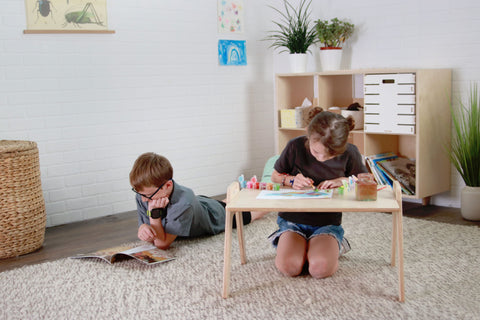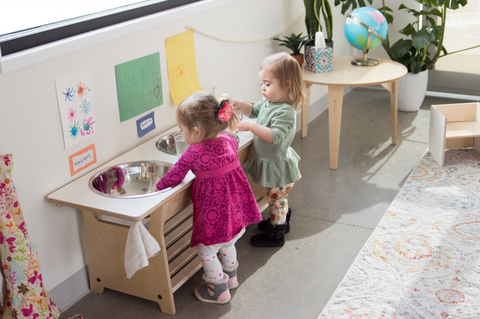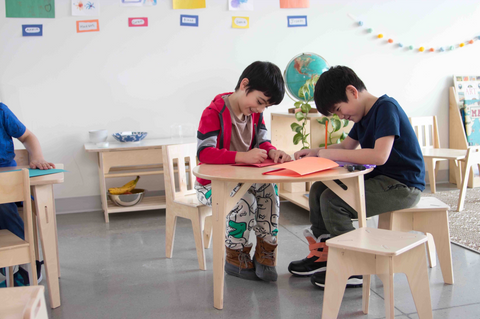
Montessori vs. Reggio Emilia
Montessori vs. Reggio Emilia
You might be familiar with the Montessori Method, but have you heard about the Reggio Emilia approach to early childhood education?
The two pedagogies have many similarities as well as some key differences. Let’s explore how they compare!
General Background
Montessori and Reggio Emilia are both educational philosophies that were developed in Italy in the twentieth century, and can now be found in early-childhood settings learning spaces worldwide.
The Montessori approach was developed by Dr. Maria Montessori, one of Italy’s first female physicians, in the early 1900s. She designed the method based on scientific observations of children’s development and natural tendencies toward learning.
The Reggio Emilia approach was also developed in Italy, in the town of Reggio Emilia, after World War II. Rather than being founded by an individual, it was created and refined by a group of educators, parents and community members, led by Loris Malaguzzi, a local educator.
Now that we know a bit more about their origins, let’s learn how these approaches are structured today, and what a Reggio Emilia school looks like compared to a Montessori school.

Similarities
Both Montessori and Reggio Emilia focus on self-guided learning, encouraging children to follow their own interests. They both stem from a foundational belief that children are not empty vessels to be filled with knowledge and information, but that they are competent and capable from birth. Known as “constructivist” approaches, both Montessori and Reggio Emilia hold the belief that children construct their own knowledge through their experiences and interactions.
Montessori and Reggio Emilia both place a strong emphasis on hands-on learning, and believe that young children learn best when they engage with the world around them through interactive sensorial experiences. They are both holistic approaches that aim to nurture all aspects of a child’s development, including physical, cognitive, emotional and social aspects.
Both approaches also believe children learn from their environment, and place a strong emphasis on creating an environment which inspires curiosity, exploration and creativity in young children. Respect for the child is an essential component of both Montessori and Reggio Emilia philosophies.

Differences
Reggio Emilia
In Reggio Emilia environments, the focus is on collaborative learning. The Reggio Emilia method is designed for children ages 3-6. Reggio Emilia features what is known as an “emergent curriculum,” meaning that the curriculum develops organically, in partnership with the children in the class. The role of the teacher is that of a co-learner, collaborator and facilitator of exploration. There is a strong emphasis placed on project-based learning, giving children the opportunity to engage in in-depth exploration of topics that interest them. These projects encourage critical thinking, problem-solving and collaboration.
Play is an important component of Reggio Emilia education, and is considered essential to how children express themselves and learn about the world around them. Reggio Emilia classrooms generally have traditional age groupings and stay with their teacher for one academic year. Children cycle through “centers” with different materials and activities that they are encouraged to play with throughout the day.
In Reggio Emilia, the environment is referred to as the “third teacher." Loris Malaguzzi said, "There are three teachers of children: adults, other children, and their physical environment.”

Montessori
The Montessori Method serves children from birth through 18, but we can compare the Reggio Emilia approach to the Montessori Children's House, a classroom of children ages 3-6. In the Montessori Children's House, there is a focus on independent, individualized learning. A general curriculum and order of materials is laid out, which the teacher then tailors to each child’s developmental needs and interests. The role of the teacher is that of an observer and a guide. The teacher observes each child's development and introduces materials and lessons designed to provide just the right challenge at just the right moment. The Montessori classroom is referred to as the Prepared Environment, meaning that it is set up to support children's independence and developmental needs.
Montessori classrooms feature mixed-age groupings of three year age spans, giving children opportunities to both learn from and teach each other. Children stay in the same classroom for three years, allowing them to develop strong bonds with their teacher and with each other. Play is seen as children’s “work,” and children engage in play through purposeful activities, as a means to explore and learn about themselves and their environment. Children choose what to work on and for how long, gradually developing their concentration and independence throughout their years in the Montessori Children's House environment.
Dr. Montessori is quoted as saying, "The adult, the child, and the environment are a trinity. They should be considered as one."

Which is better?
Every child is unique, and might learn better from one approach than the other. However, both approaches have been effective and meaningful for thousands of children and their families. Both share a strong focus on supporting and facilitating children’s development through exploration and hands-on learning experiences. Despite their differences, both have had an enduring impact on approaches to early childhood education and continue to inspire schools, educators and parents around the world.
Have you been inside a Montessori or Reggio Emilia classroom? What did you notice about the environment?
Some other approaches to early childhood education are the Pikler Approach, founded by Dr. Emmi Pikler, and the Waldorf Approach. If you're interested in learning more, we also have articles that highlight the backgrounds and methods of Montessori and Pikler and Montessori and Waldorf.

For me in the title “vs” connotes antagonism. I like to consider Reggio and Montessori.
A few years ago Katherine Ross wrote about this.
Sheryl Morris on
Wonderful reflection, Gabrielle. Knowing your family background of gifts and service, you are in the flow. Maybe say more. About the philosophical origins in Steiner tradition
Michael Christensen on